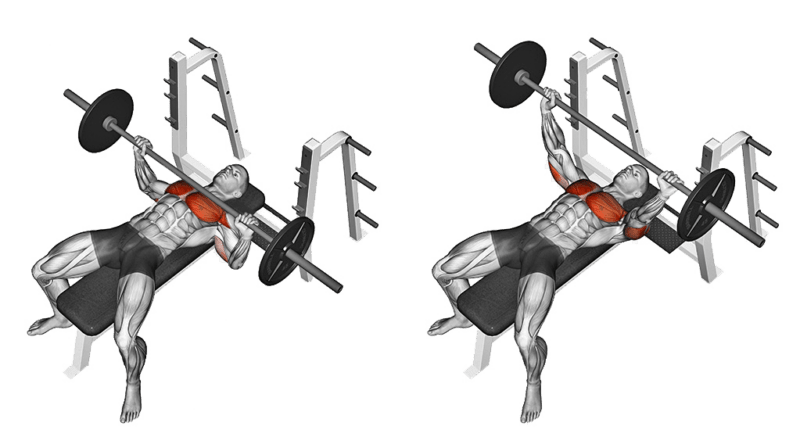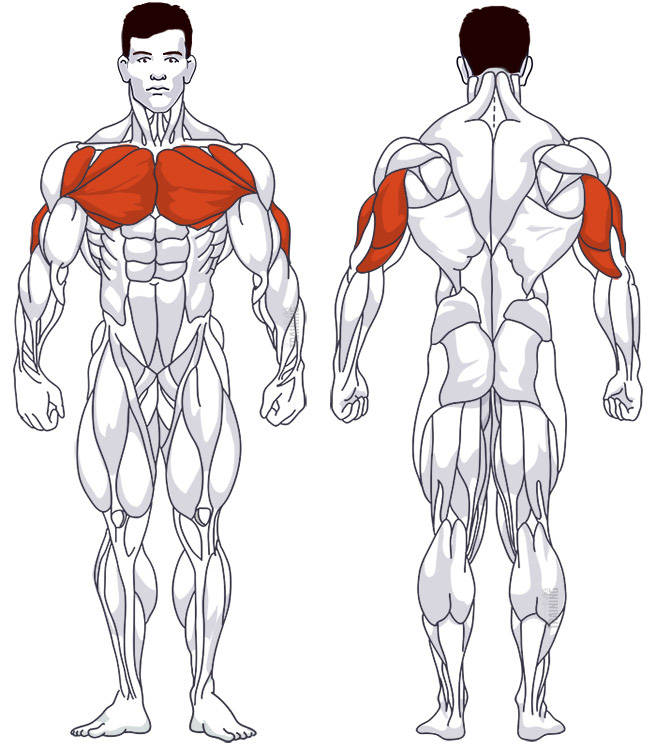Bench Press
Compound exercise, Free weightsThis article is verified by 2 studies/publications.
Overview

Main muscles
- Chest: Large pectoral muscle
(Musculus pectoralis major) - Chest: Small pectoral muscle
(Musculus pectoralis minor) - Shoulder: Anterior deltoid muscle
(Musculus deltoideus, Pars clavicularis) - Triceps: Three-headed arm muscle
(Musculus triceps brachii)
Training plans
Here you can find example plans for bench press training:
Bench Press: Basics and alternatives

Involved main muscle groups:
Bench Press
The bench press is a crucial core exercise not only in bodybuilding but also in various other strength-related sports[1]. While lying on a flat bench, you press a barbell vertically upwards from your chest.
This exercise is excellent for selectively targeting chest muscles, making it a staple in nearly every training plan. Bench press, squats, and deadlifts together constitute powerlifting.
There are several variations of the bench press, such as: Dumbbell Bench Press, Incline Bench Press, and Negative Bench Press.
Correct execution
Although the bench press is a common exercise, it’s often done incorrectly. Mistakes can be made in the lying position, shoulder position, grip, lowering position, and movement sequence.
To bench press effectively, you need a high training stimulus, which can be best achieved with proper form: Try to reducing the angle between your upper arm and torso, instead of spreading your elbows, and also form a hollow back when lying on the flat bench, also known as the “bridge“.
If you’re new to bench pressing, start with just the barbell without weights. This way, you’ll quickly learn the movement as a beginner, without much risk of injury.
Video tutorial
Step-by-step instructions
Lie on the flat bench with your back. The barbell bar in the holder should be at about eye level.
Keep your feet firmly on the ground. At the gym, some people lift their legs or place their feet on the bench, but you should avoid this. Keeping your feet on the ground provides the best stability.
Retract your shoulder blades.
Press your feet onto the floor and tense your lower back. That way you form a slight hollow back – the so-called “bridge”.
Extend your arms straight up and reach for the barbell. Then, move your hands outward by one hand width. Your grip should now be slightly wider than shoulder-width. A grip that’s too narrow will focus more on the triceps and less on the pectoral muscles, while a grip that’s too wide will activate the shoulder more. However, the optimal grip depends on your individual physique.
When gripping the barbell, your thumb should wrap around the bar for safety. Don’t use the so-called monkey grip (see below).
Lift the barbell bar out of the rack. Avoid bending your wrists too much.
Lower the bar evenly above your chest, not too fast. Keep your elbows directed downwards, towards your feet, rather than spreading them outwards to the sides. Keep your shoulder blades tucked in during the entire movement. Inhale as you lower the bar.
The exact spot where the barbell lands when you lower it depends on your individual anatomy. For some, it’s around nipple level, while for others it’s slightly above or below. Make sure not to lower the bar too close to your neck.
Opinions differ on whether the bar should touch your chest or not. As long as you don’t rest the weight on your body or use momentum to bounce it off your chest, it shouldn’t matter too much.
Perform the upward movement as quickly and evenly as possible, exhaling as you do so.
Once at the top, maintain body tension, avoid fully extending your arms, and repeat.
Spotter during bench press
A spotter is someone who supports the trainee and can help complete a repetition.
During the bench press, a single spotter stands either behind the flat bench at the head of the trainee or two spotters stand next to the bench. In the gym, you’ll typically find a single person. If you want to train to muscle failure and don’t have a power rack or Smith machine available, it’s a good idea to ask someone at the gym for a little help. Experience shows that this is usually not a problem and can be done quickly during set breaks.
As a spotter, stand securely at the head of the flat bench. It’s best to ask upfront how many repetitions your training partner plans to do. Only intervene if you notice that the trainee can’t complete a repetition alone. Too much intervention, which reduces the training stimulus, is generally not appreciated.
Fun fact: One study has shown that simply having a spotter present during bench press can help you complete more reps. This not only provides short-term assistance but also long-term advantages in strength gains if you train with others.
Bench press without spotter, with safety
If you can’t find a spotter, you can still perform the bench press safely using various training equipment.
The first option is a power rack, which is the best choice for safe bench pressing with free weights. A power rack is suitable for both gym and home gym use. Just position the safety bars correctly so they don’t interfere when you lower the barbell.
Here’s the best way to do it: As mentioned above, form the “bridge” during the bench press. This ensures that the barbell doesn’t touch the safety bars when lowering. If you can’t push the weight for another rep, release body tension and the bridge slowly. Now place the weight on the safety bars.
The second option for bench pressing safely without a spotter is using a Smith machine. While some bodybuilders frown upon the Smith machine because the guided bar motion results in less activation of supporting muscles, the main muscles can still be targeted effectively. This makes it an easy and safe option for lifting heavy weights alone.
The third option involves using safety spotter arms placed next to the flat bench. However, be aware that due to their free placement, the arms may not protect against every situation, as demonstrated in the following video.
Common mistakes and injuries
Avoid lowering the weight too quickly. You should bring the bar back up as quickly as possible, but you must not bounce it off your chest with momentum. Not only can this cause injury, but it also reduces the overall impact compared to performing the exercise correctly.
Ensure you maintain the correct posture for your elbows and shoulders/shoulder blades, as described above. Otherwise, excessive stress may be placed on the joints, which can be problematic in the long run. Performing the exercise incorrectly also reduces the training effect on the chest muscles[2].
Monkey grip, yes or no?
A common question relates to the grip when bench pressing. Should the thumb grip the bar or be placed with the other fingers? To put it simply, it’s safer to grip the bar with the thumb (closed grip). This helps secure the weight against rolling off your palm, so it’s a good habit to develop from the start.
The thumbless grip is also known as the “suicide grip“. The biggest issue with this grip is the lack of bar security toward the legs. If you lose momentum, become careless, or both, you might lose your grip and drop the bar. The consequences of that can be severe.
So why is the thumbless grip used at all? Many claim it allows for better muscular awareness and reduces pain in the upper arms and shoulders. Additionally, placing the thumb next to the other fingers makes it easier to guide the elbows close to the body rather than spreading them outward.
Despite numerous warnings, the monkey grip is still being used. If you decide to use the thumbless grip, it’s best to do so only in a power rack. Make sure to place the safety bars high enough so that if there’s an accident, the barbell lands directly on the safety bars and not on you.
Sources
- The Effects of Offset Loading Versus Traditional Loading in the Bench Press Exercise on Muscle Thickness and Strength in Trained Males. Sharp M, Ottinger C, Gheith R, et al. Journal of Science in Sport and Exercise. 2022. doi: 10.1007/s42978-022-00200-1.
- The Effects of Bench Press Variations in Competitive Athletes on Muscle Activity and Performance. Saeterbakken AH, Mo DA, Scott S, Andersen V. Journal of Human Kinetics. 2017;57(1). doi: 10.1515/hukin-2017-0047.